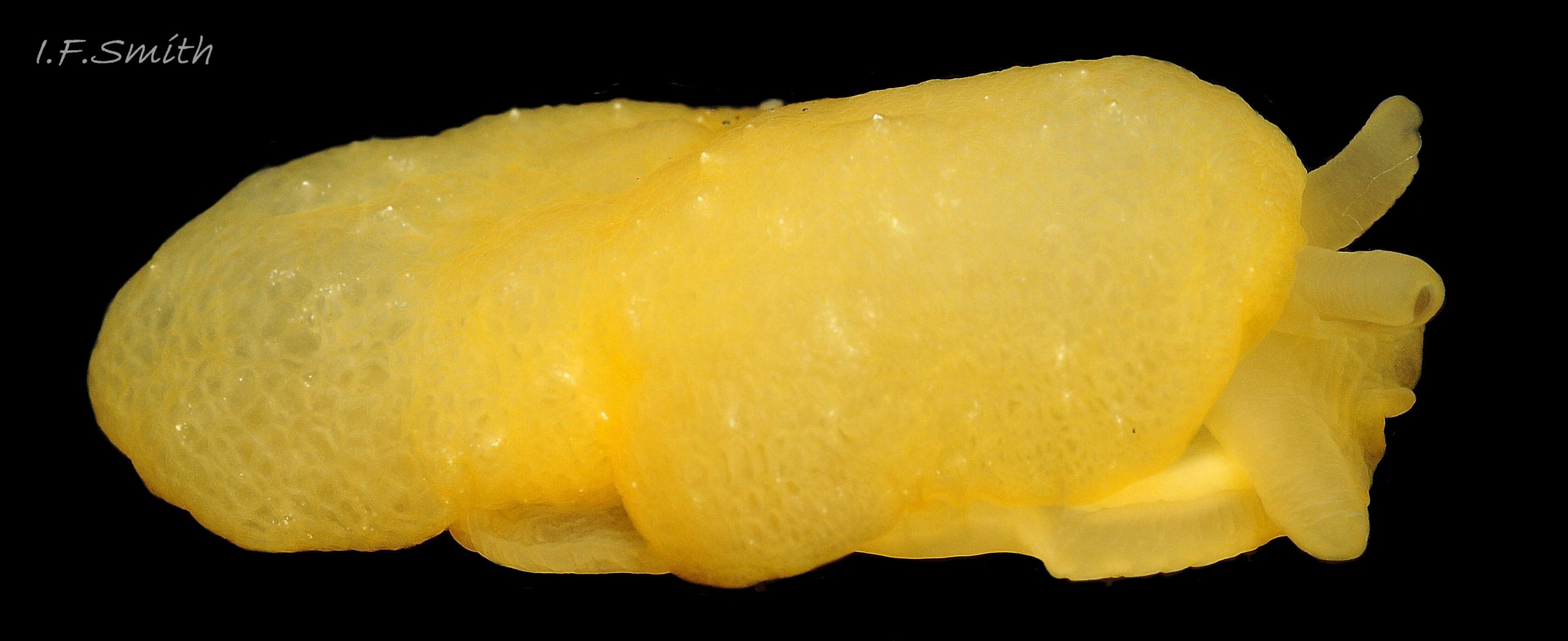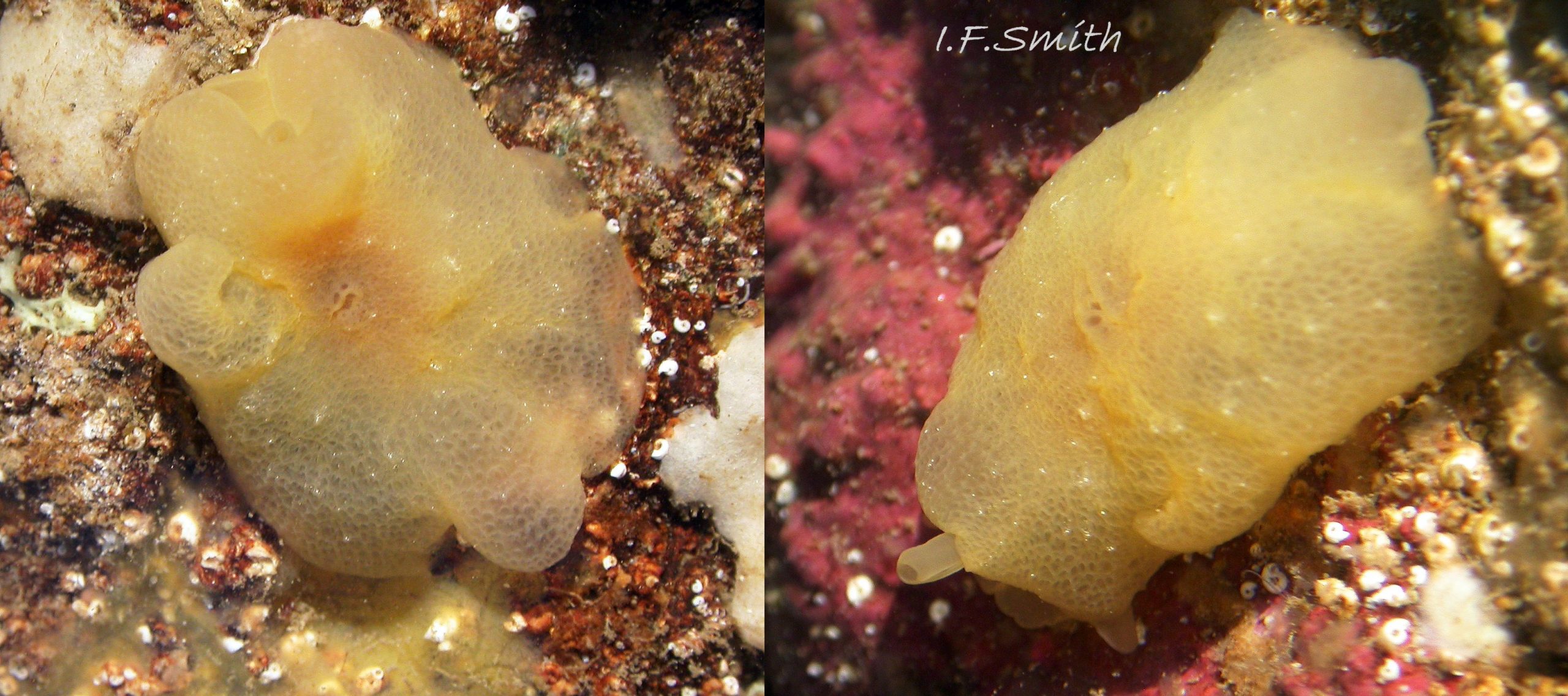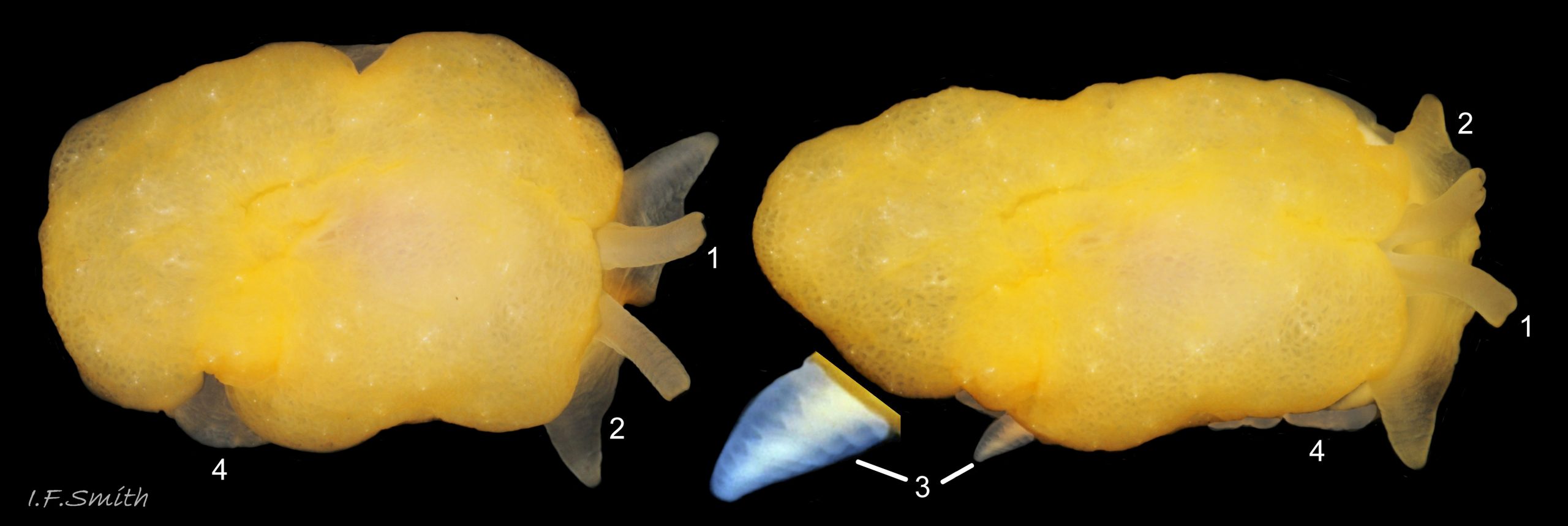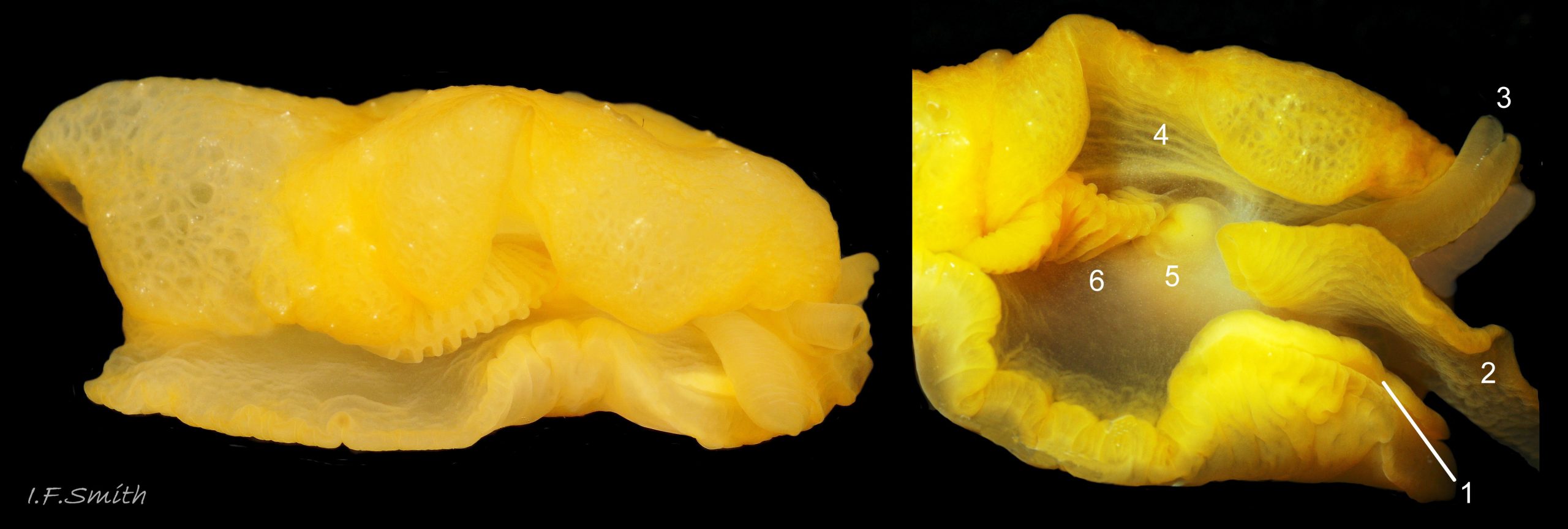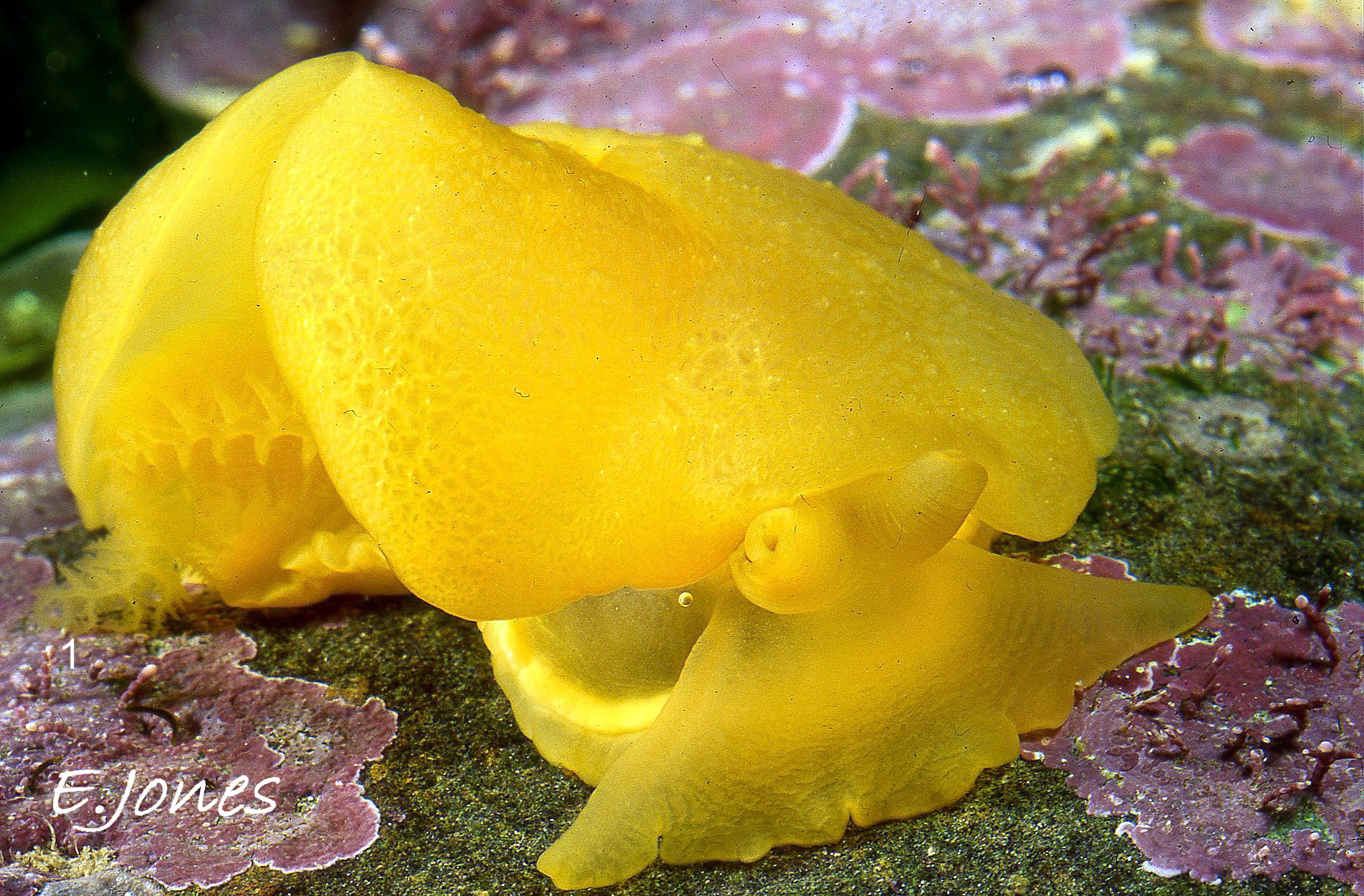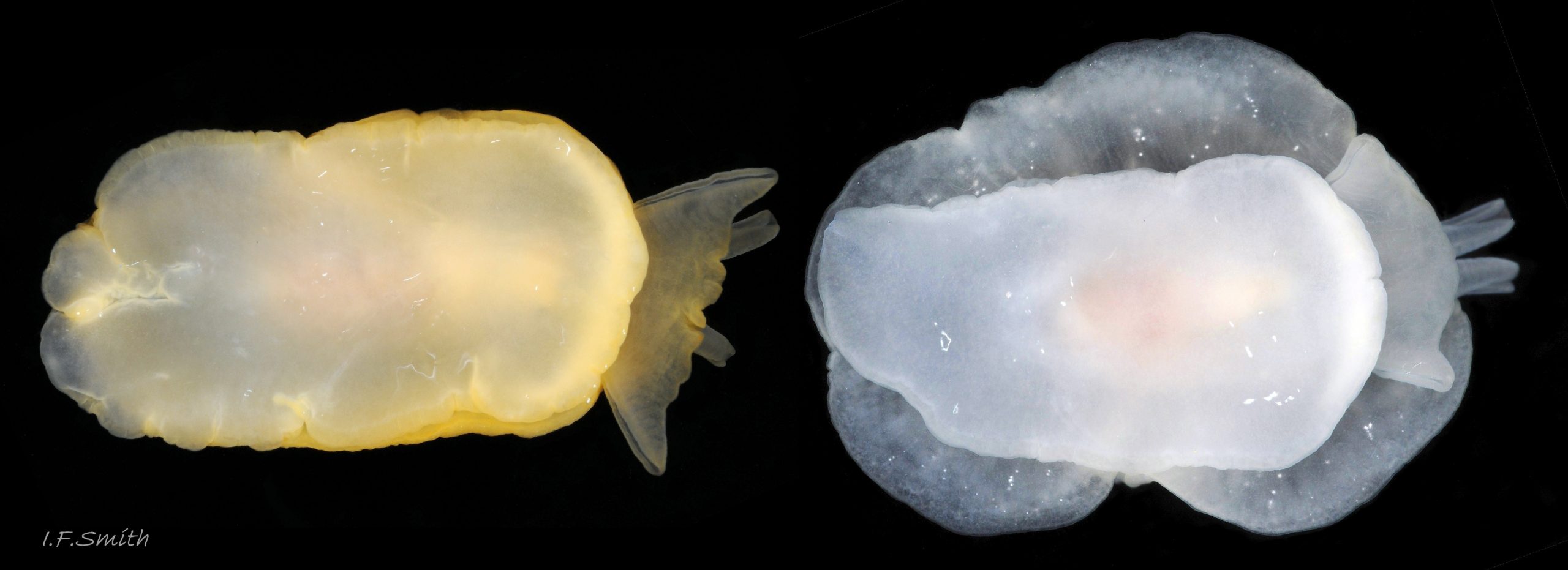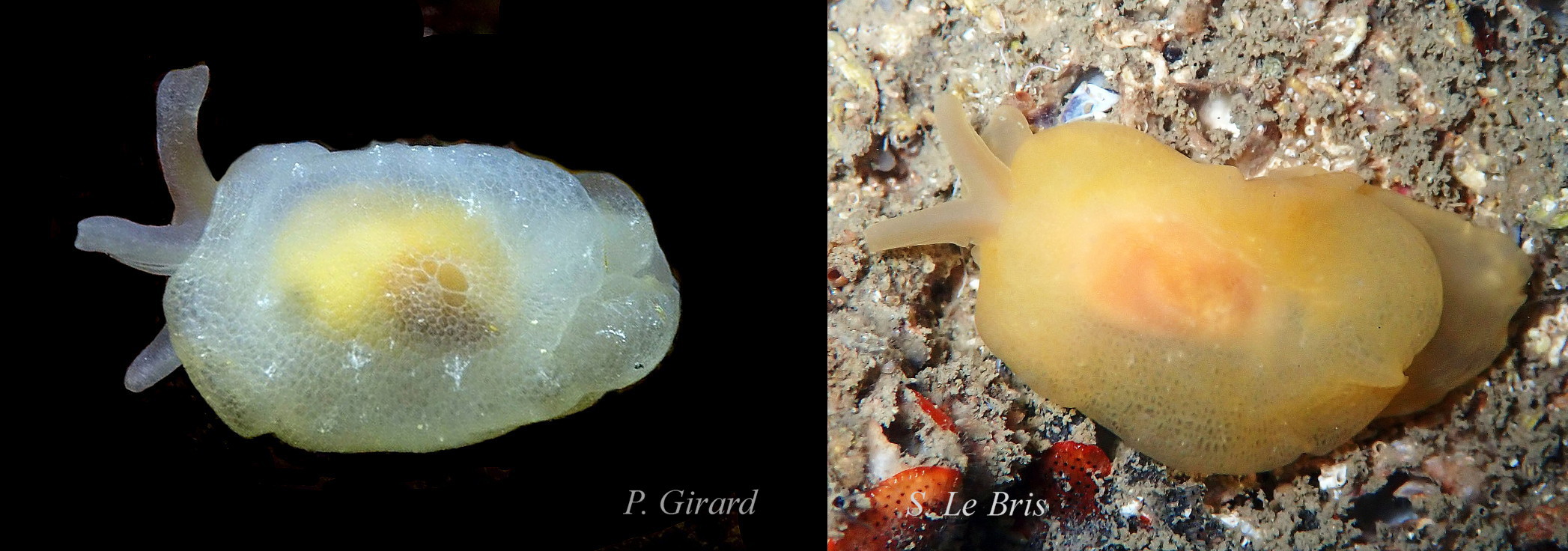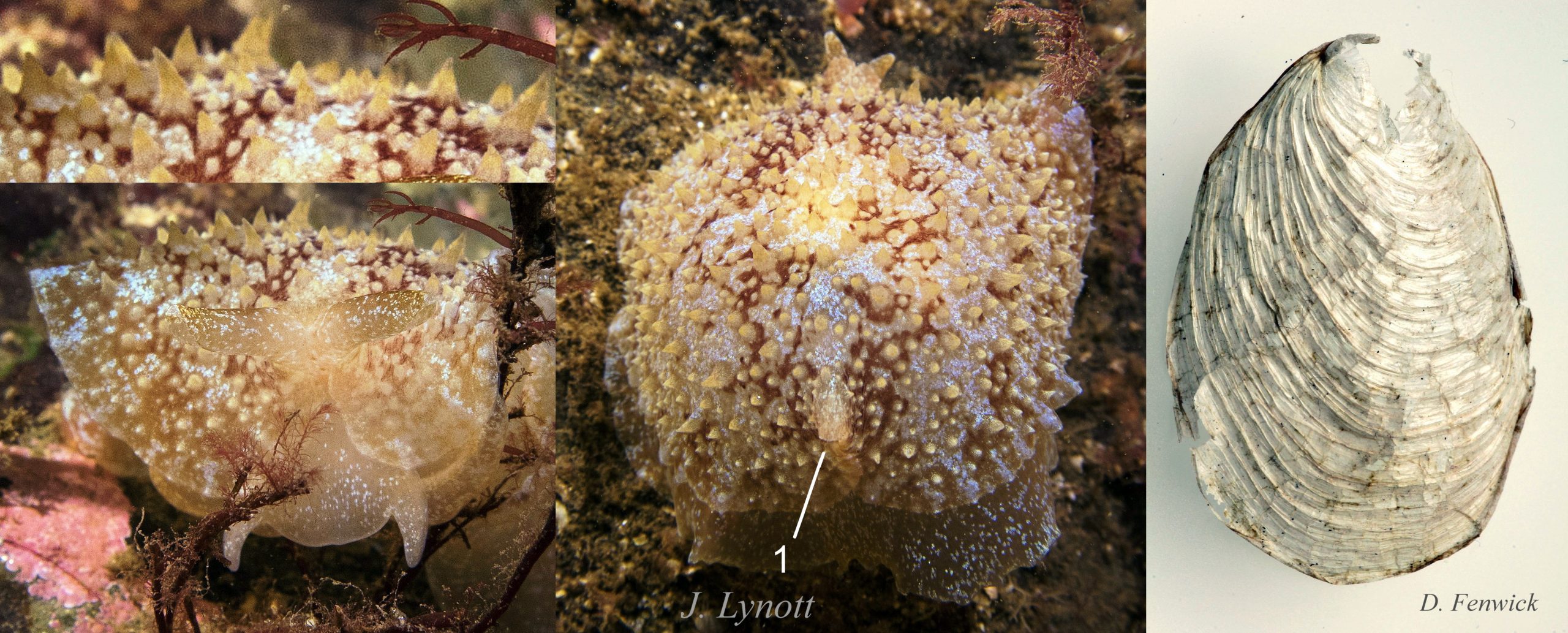Click image to enlarge with full caption. Main text below slider.
Berthella plumula (Montagu, 1803)
PDF available at www.researchgate.net/publication/354544870_Berthella_plum…
Current Taxonomy: World Register of Marine Species www.marinespecies.org/aphia.php?p=taxdetails&id=140812
Synonyms: Bulla plumula Montagu, 1803; Pleurobranchus plumula (Montagu, 1803).
Vernacular: Yellow-plumed sea slug; Gelber Atlantischer Flankenkiemer (German).
Body description
The body is up to 60 mm long. The mantle lacks tubercles, but has sparse, small, white pustules ( 01 Berthella plumula), and sometimes puckers or folds ( 02 Berthella plumula). It is various shades of yellow ( 02 Berthella plumula) or whitish ( 03 Berthella plumula) with slightly raised, opaque, reticulating lines enclosing variably translucent areas which appear to be impressed and to resemble lobules of its prey, Oscarella, an encrusting sponge. Especially on the more translucent specimens, a large, transparent, central area, which reveals the darker shell and viscera, resembles the exhalant opening of Oscarella ( 03 Berthella plumula). The reticulating lines are often less prominent on the more opaque specimens ( 01 Berthella plumula). Colour variations may be due to age or consumption of the different colour forms of Oscarella; beige, yellow or orange. The ample mantle covers the whole body apart from the rhinophores, oral veil and a small part of the foot when they are extended ( 03 Berthella plumula & 04 Berthella plumula). It can be contracted to match the extent of the foot or extended far beyond it ( 08 Berthella plumula).
The profile varies from a high to flat-topped dome ( 02 Berthella plumula & 03 Berthella plumula ) . At rest, the body is usually approximately a round-based, dome and superficially resembles a dorid nudibranch, but there are no rhinophores or gill on the mantle surface ( 02 Berthella plumula & 03 Berthella plumula). When moving, the base lengthens to an ellipse or oblong with rounded corners ( 04 Berthella plumula).
A single corrugated gill ( 05 Berthella plumula & 06 Berthella plumula) is adnate (attached) for two thirds of its length to the right side of body between the mantle and foot (Thompson, 1976); the distal third is plumose. It is usually concealed by the mantle, but the tip sometimes protrudes ( 04 Berthella plumula). Occasionally the mantle flexes up to aid respiration and may reveal the whole gill ( 05 Berthella plumula & 06 Berthella plumula). The common genital opening is to the anterior of the gill, and the anus is to its posterior.
Short, stout enrolled rhinophores ( 07 Berthella plumula) project forwards, diverging at about 45° ( 03 Berthella plumula), from between the anterior edge of the mantle and the oral veil.
The head is usually concealed, apart from the rhinophores and oral veil extending forwards from under edge of mantle. The corner angles of the bilaminate veil are acutely extended ( 07 Berthella plumula ) into triangular flaps slit open at the sides. The
sole has straight sides and convex ends ( 08 Berthella plumula); the edges are often wavy or indented. The posterior is often tapered ( 08 Berthella plumula) and the anterior is widely bilaminate ( 05 Berthella plumula). The sole is paler than the dorsal surface of the mantle ( 08 Berthella plumula). Only a small portion of it extends beyond the mantle ( 03 Berthella plumula).
Shell description
The shell ( 09 Berthella plumula ) is approximately oblong with rounded corners. Its longest dimension (height) is greater than 40% of the body length, with a maximum of about 30 mm. It is fragile and permanently enclosed in the body. The adult shell is pale reddish brown with a milky white periostracum on the exterior and a white interior ( 09 Berthella plumula). Young shells are translucent whitish with little pigment. Both interior and exterior are slightly glossy and the exterior often shows some iridescence ( 09 Berthella plumula). The exterior has many distinct growth lines and numerous, close-set, microscopic, longitudinal striae, most distinct near the spire, especially on iridescent areas ( 09 Berthella plumula). The shell and viscera below it can often be discerned ( 03 Berthella plumula ) as a dull orange shape inside live specimens with translucent white bodies. Most of the adult shell consists of the shallow, large final whorl. The spire of two whorls is very small with a recessed apex ( 09 Berthella plumula) and the large aperture extends the entire shell height and projects slightly beyond the apex. Very early growth stages (10 Berthella plumula) have a relatively large spire and small body whorl, and the crossing of the growth lines by the longitudinal striae forms a distinct cancellated pattern under magnification at this stage.
Key identification features
Berthella plumula
1. Body length to 60 mm.
2. Approximately oblong shell to 30 mm long, more than 40% of body length.
3. Mantle has variable translucency and shades of yellow ( 02 Berthella plumula & 03 Berthella plumula) or white, with reticulating lines around apparently impressed marks. Often it has a central transparent area.
4. The mantle rim is not curved up to form an exhalant siphon, and its dorsal surface has no tentacles, gills or tubercles (apart from a few white pustules), and there is no large, central, dorsal, opaque white mark.
5. Identified with DNA sequencing of specimens from the Atlantic but not the Mediterranean (as of August 2021).
Similar species
Berthella perforata (Philippi, 1844) ( 11 Berthella plumula)
Molecular evidence (Ghanimi et al. 2020b) shows that specimens formerly regarded as B. plumula in the Mediterranean are a different species from those in the Atlantic. The name Berthella perforata (Philippi, 1844), previously regarded as a synonym, was suggested for the Mediterranean specimens, and it has been accepted by WoRMS. A translation of Philippi’s description is in the appendix, below. Some specimens of B. perforata are morphologically very similar to north-eastern Atlantic, DNA determined B. plumula; and some B. perforata resemble B. stellata. The advice of the corresponding author for Ghanimi et al. (2020b) is to work under the assumption that all British Berthella specimens are B. plumula (2021, Á. Valdés, pers. comm. 20 August) unless and until further DNA sequencing of specimens reveals B. perforata in the north-eastern Atlantic .
1. Body length c. 30 mm (Philippi, 1844).
2. Shell similar to B. plumula, more than 40% of body length.
3. Mantle colours and patterns similar to B. plumula with reticulating lines around apparently impressed marks (Ghanimi, 2020b).
4. The mantle rim is not curved up to form an exhalant siphon, and its dorsal surface has no tentacles, gills or tubercles (apart from a few white pustules), 5. Identified with DNA sequencing from the Mediterranean but not the north-eastern Atlantic (Ghanimi, 2020b).
Berthella stellata (Risso, 1826) ( 12 Berthella plumula).
1. Body length to 35 mm (Trigo et al., 2018).
2. Oval, convex shell more than 40% of body length.
3. Mantle translucent cream to reddish brown, covered with irregular low ridges. Often, but not always, there are many small opaque white marks and/or a large, central, dorsal, opaque white mark (Y, transverse bar or irregular blotch).
4. The mantle rim is not curved up to form an exhalant siphon, and its dorsal surface has no tentacles, gills or tubercles.
5. Mediterranean and north-eastern Atlantic as far north as Brittany. Records of B. stellata from elsewhere in the world have been segregated with DNA to several other species (Ghanimi, 2020b).
Pleurobranchus membranaceus (Montagu, 1816)
1. Body length to 120 mm.
2. Oval shell to 50 mm long, about 40% of body length.
3. The adult mantle is partly brown ( 13 Berthella plumula), but juveniles are whitish ( 14 Berthella plumula)
4. The adult mantle has large, soft, retractile, conical tubercles, but no tentacles or gills on its surface ( 13 Berthella plumula). It is sometimes curved up at the posterior to form an exhalant siphon. Early stage tubercles on juveniles are blunt and low ( 14 Berthella plumula).
5. Occurs from Norway to the Mediterranean. Not in the Baltic, and scarce or absent in southern North Sea.
Lamellaria perspicua (Linnaeus, 1758)
Detailed account at Lamellaria perspicua
1. Body length to 23 mm, occasionally 30 mm.
2. Ear-shaped shell to 20 mm long, about 60% of body length.
3. The mantle has a great variety of colours and patterns ( 15 Berthella plumula).
4. The mantle is often roughly tuberculated. It has no tentacles or gills on its surface, but is usually curved up at the anterior to form a respiratory siphon.
5. Occurs from Norway and Iceland to the Mediterranean. Not in the inner Baltic, and scarce or absent in southern North Sea.
Trivia arctica (Pulteney, 1799) & T. monacha (da Costa, 1778), juveniles. Full accounts at Trivia arctica & Trivia monacha
1. Body length circa 10 mm.
2. Coffee bean-shaped shell almost as high as body length, exposure varies.
3. The variably extended mantle is whitish, sometimes with dark marks.
4. The mantle often has white or yellowish papillae, but no tentacles or gills on its surface. When active, the mantle is extended at the anterior to form a respiratory siphon. ( 16 Berthella plumula)
5. Occur from western Mediterranean to Shetland (T. monacha) / northern Norway (T. arctica).
Berthellina edwardsii (Vayssière, 1897)
opistobranquis.info/en/guia/pleurobranchida/berthellina-e…
1. Body length to 60 mm.
2. Small shell <30% length of body, maximum height 5.5 mm. Small spire protrudes slightly beyond aperture.
3. Mantle yellow to red-orange, not reticulated. It has no tubercles, tentacles or gills on its surface.
4. The mantle rim is not curved up to form exhalant siphon.
5. Mediterranean and Atlantic coast of southern Europe, to Brittany?
Berthellina citrina is common in the Indo-West Pacific and adjacent temperate waters. In the past, its name has been misapplied to European species and is used (4 Sept. 2021) for the uncertain, single Berthellina record on NBN.
Habits and ecology
Berthella plumula lives near its sponge prey, Oscarella spp. (www.habitas.org.uk/marinelife/species.asp?item=C960 ) in clean seawater on shores near LWS, and, in British waters, sublittorally usually to 10 m, occasionally to 20 m. It may go deeper in the North as it is reported at 20 m in Shetland and 25 m in south-western Norway. On shores, it is found under stones and in clean rock pools. It moves very slowly and defends itself from attack by secreting sulphuric acid.
It is a simultaneous hermaphrodite. A spirally coiled, cream or yellow ribbon of spawn is attached by its edge to rock in late spring ( 17 Berthella plumula spawn. ). When newly laid, the ribbon has clear borders unoccupied by ova. The upper edge of the spiral ribbon is bent evenly outwards without undulations; viewed from above it could be mistaken for a spiral cylinder. Veliger larvae with external shells live as part of the plankton before settling on the sea floor and transforming into adults.
Distribution and status
B. plumula is reported in the Atlantic from Norway to the Azores and Canary Islands but not in the Baltic and it is scarce or absent from the continental coasts of the southern North Sea. It is apparently absent from the Mediterranean, where B. perforata was formerly mistaken for it (Ghanimi, 2020b). The precise limits of the two species, and possible overlaps of their ranges, require further DNA based investigation of large samples from a wide range of localities. The GBIF map includes Mediterranean finds which are probably B. perforatawww.gbif.org/species/2302622 . It is common on hard substrate in clean water around most of Britain and Ireland, but it is scarce or absent from the north-eastern Irish Sea and from Kent to Flamborough head, UK map, NBN species.nbnatlas.org/species/NBNSYS0000174119 .
Acknowledgements
I am most grateful to Ángel Valdés for valuable information and advice and to David Fenwick, Pascal Girard, Evan Jones, Sylvain Le Bris, Antoni López-Arenas, James Lynott, Tim Nicholson and Mathias Meunier & Lou Valence for use of their images. I thank the following divers for approximate reports of their deepest finds of B. plumula in British waters: Becky Hitchin (7 m), Tamsyn Mann (8 m), Chris Rickard (8 m), David Kipling (10 m, except one in over 25 years at 18 m on a vertical wall down which it may have fallen), Tim Nicholson (20 m in Shetland) and, in SW Norway, Erling Svenson (25 m).
References and links
Aphotomarine. Photographs of British marine life. www.aphotomarine.com/
Forbes, E. & Hanley S. 1853. A history of the British mollusca and their shells. vol. 3, London, van Voorst.
archive.org/details/historyofbritish03forbe/page/559/mode…
Ghanimi, H., Goddard, J.H.R., Chichvarkhin, A., Gosliner, T.M., Jung, D.-W. and Valdés, Á. 2020a. An integrative approach to the systematics of the Berthella californica species complex (Heterobranchia: Pleurobranchidae). J. Molluscan Stud. 00: 1–15. www.researchgate.net/publication/341359027_An_integrative…
Ghanimi, H., Schrödl, M., Goddard, J.H.R., Manuel Ballesteros, M., Gosliner, T.M., Buske, Y. and Valdés, Á. 2020b. Stargazing under the sea: molecular and morphological data reveal a constellation of species in the Berthella stellata (Risso, 1826) species complex (Mollusca, Heterobranchia, Pleurobranchidae) Marine Biodiversity. 50:11. © Senckenberg Gesellschaft für Naturforschung. Abstract at www.researchgate.net/publication/338900142_Stargazing_und…
Jeffreys, J.G. 1862-69. British conchology. vol. 5 (1869). London, van Voorst. archive.org/details/britishconcholog05jeffr/page/11/mode/1up
Montagu, G. (1803). Testacea Britannica or natural history of British shells, marine, land, and fresh-water, including the most minute: Systematically arranged and embellished with figures. J. White, London. Description p. 214 www.biodiversitylibrary.org/item/78694#page/264/mode/1up
Plate 15 (shell) www.biodiversitylibrary.org/item/78694#page/693/mode/1up
OPK opistobranquis (accessed 4 September 2021) Berthellina edwardsii
opistobranquis.info/en/guia/pleurobranchida/berthellina-e…
Philippi, R. A., 1808-1904. Fauna molluscorum viventium et in tellure tertiaria fossilium regni utriusque Siciliae [p.87 Description of Pleurobranchus perforatus; translation in Appendix, below.] www.biodiversitylibrary.org/page/46936062#page/429/mode/1up
Plate XXI www.biodiversitylibrary.org/page/46936062#page/663/mode/1up
Picton, B.E. & Morrow, C.C., 2010. Encyclopedia of Marine Life of Britain and Ireland.
www.habitas.org.uk/marinelife/index.html
Thompson, T.E. 1976. Biology of opisthobranch molluscs 1. London, Ray Society.
Trigo, J.E.; Diaz Agras, G.J.; Garcia Alvarez, O.L.; Guerra, A.; Moreira, J.; Pérez, J.; Rolán, E.; Troncoso, J.S,; Urgorri, V.. 2018. Guia de los Moluscos Marinos de Galicia. Servicio de Publicacións da Universidade de Vigo.
Current Taxonomy: World Register of Marine Species www.marinespecies.org/aphia.php?p=taxdetails&id=140812 and
www.marinespecies.org/aphia.php?p=taxdetails&id=1446148 (B. perforata)
Appendix: translation of original description B. perforata by Philippi (1844). [From a preserved, faded, distorted specimen with broken shell.]
4. Pleurobranchus perforatus n. sp. plate XXI, .
Pl. body ovate-elliptic, convex. Mantle with numerous impressed dots, as if it were perforated, anterior blunt; mantle extensive as the foot. Shell large.
Delle Chiaje ined. t. XCVl. 1? nom. Pl. Peronii?
I owe to my good friend, W. Sartorius of Waltershausen, a specimen preserved in alcohol from Catania; the length is 13½’” [30.5 mm], the width is 8½’” [19.2 mm], the height is 6½’” [14.7 mm]. The mantle is very convex, blunt anteriorly, rounded posteriorly, obsolete warty at the sides, with dots deeply impressed on all sides, or with glands (?) as if perforated. The foot is 12′” [27.1 mm] long, and 6½’” [14.4 mm] wide, truncated anteriorly, with rounded corners, pointed posteriorly, the body is much wider than it. The veil of the head is 5½’”[12.4 mm] wide, with a straight truncate anterior: the gills commence at half the length of the body, and are extended almost as far as the tip of the foot, but are adnate [attached to the body] for up to ¾ of their length. The anus and vulva are in the usual place. No trace of colour remained. The dorsum of the body showed a very thin shell extending to ¾ of the body’s length, the shape of which I was unable to determine, because it had been broken.
Glossary
1′” = 1 ligne/line = 2.26 mm. (Unit of measure used in early 19th Century.)
adnate = joined by having grown together.
bilaminate = (adj.) formed of two layers.
body whorl = most recent and largest whorl of a gastropod shell, which accommodates the withdrawn body, apart from viscera in the spire.
distal = away from centre of body or from point of attachment.
dorid = a sea slug in the infraorder Doridacea; with gills and rhinophores on the dorsum; often shaped like half a lemon or grape.
hermaphrodite, simultaneous = individual acts as both male and female at the same time with similar partner(s).
lobule = small lobe
LWS = low water spring tide, two periods of a few days each month when tide falls lowest.
mantle = sheet of tissue that secretes the shell, covers the viscera and forms a cavity in gastropods.
oral veil = anterior extension of head into a flat sheet.
periostracum = thin horny layer of conchiolin often coating shells.
plumose = shaped like a feather with many side branches along a central shaft.
pustule = pimple
rhinophore = chemo-receptor tentacle; many sea slugs have a pair on top of the head.
spire = all whorls of a gastropod shell, except the final body whorl.
striae = (sing. stria) usually parallel, slight, fine or narrow furrows, ridges, stripes, or streaks.
veliger = shelled larva of marine gastropod which moves by action cilia on a velum (bilobed flap).
